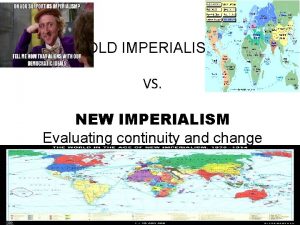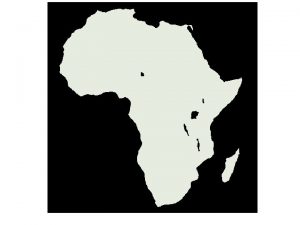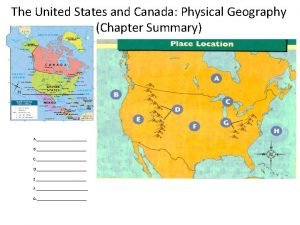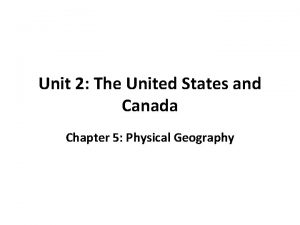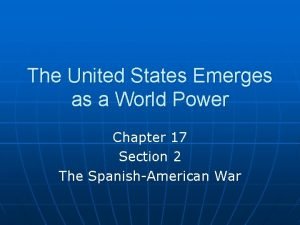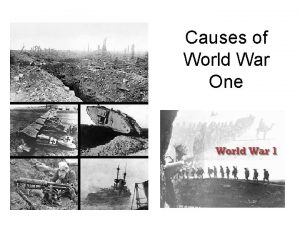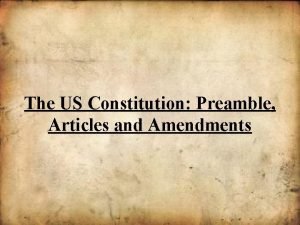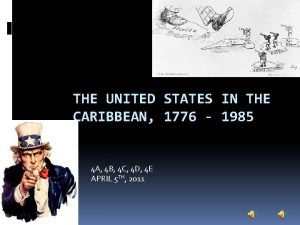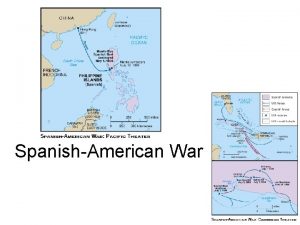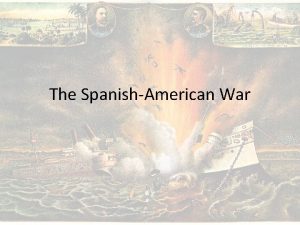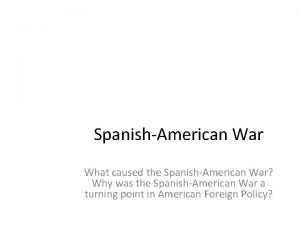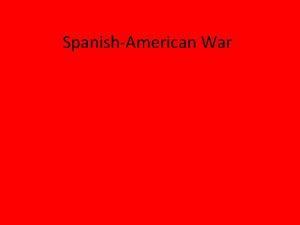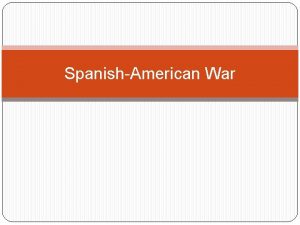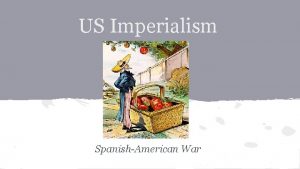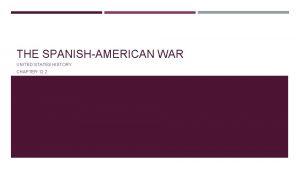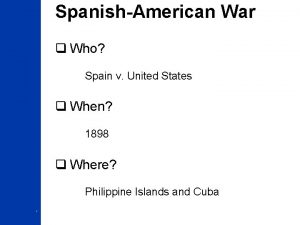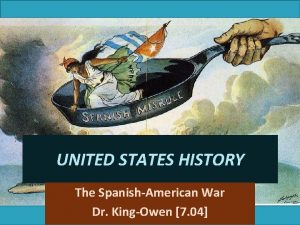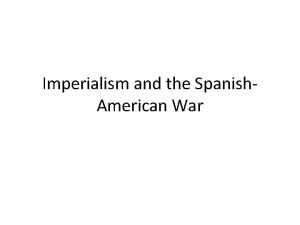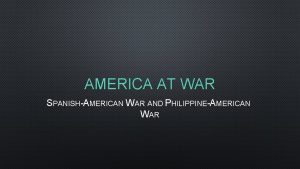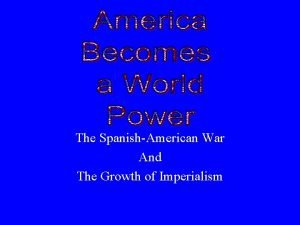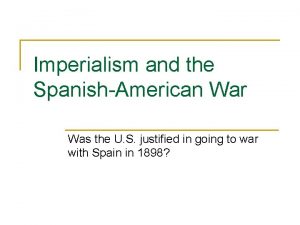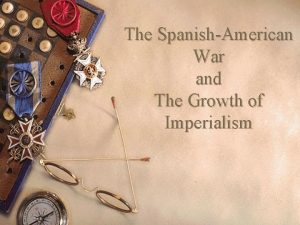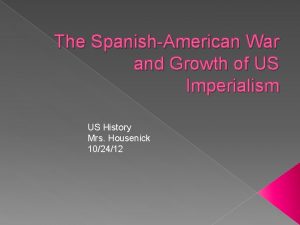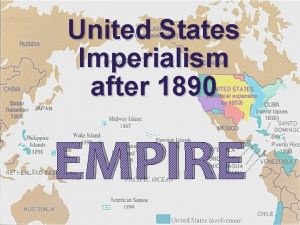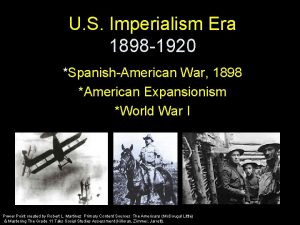The SpanishAmerican War IMPERIALISM AND THE UNITED STATES




















- Slides: 20

The Spanish-American War IMPERIALISM AND THE UNITED STATES

Reasons for U. S. Expansion � � � Imperialism: policy by which stronger nations extend their economic, political, or military control over weaker nations Manifest Destiny Increase the nation’s financial prosperity Strengthen the military force Spread democracy Spread western culture

“A Splendid Little War” Lasted less than one year � A major shift in world power resulted from its outcome. � The war was fought on two islands � �Philippine Islands �Cuba

Why did the U. S. enter the war? � It’s important to know and understand why the United States entered the war. There was more than one reason… �American leaders were not pleased with the harsh treatment of Cubans (see next slide). �American leaders were worried Cuba’s many attempts at revolting against Spain would threaten U. S. trade with Cuba. � American leaders wanted to help Cubans obtain their freedom from Spain

Cuban Revolution Cubans rebelled against Spanish control Many Cubans were forced from their homes and placed in camps guarded by Spanish troops � Thousands died of starvation and disease � �

Yellow Journalism � Most Americans’ � Competition between depended on journals, different forms of newspapers, and media led to a style of magazines to learn writing called Yellow about what was Journalism. happening in the world. � � Americans were outraged when they learned about the harsh treatment of Spanish officials. Yellow Journalism: style of journalism that exaggerates and sensationalizes the news

America Declares War! President William Mc. Kinley did not want the U. S. to enter the war. � Eventually public opinion swayed Mc. Kinley to take action. � He sent the battleship, USS Maine to Cuba to protect U. S. citizens from revolts � On February 15, 1898, the USS Maine exploded and sank. � �Many Americans blamed Spain for the explosion

“Remember the Maine!”

Destruction of the Maine

America Declares War! � By April of 1898, Mc. Kinley called for Cuba’s independence and demanded Spain to withdraw their forces. � Spain responded by breaking off diplomatic relations with the U. S. � Despite Mc. Kinley’s hesitation to enter the war, it became evident that the U. S. would need to do something

The War in the Philippines On April 30, 1898, American ships began the trip to the islands, prepared to help Filipinos in their revolt against Spain � On May 1, 1898 Commodore George Dewey, with the help of Emilio Aguinaldo, the head of the Filipino rebel forces, gave the command to open fire against the Spanish fleet. �

The War in the Philippines On May 1, 1898 Commodore George Dewey, with the help of Emilio Aguinaldo, the head of the Filipino rebel forces, gave the command to open fire against the Spanish fleet.

The War in the Philippines Commodore George Dewey Emilio Aguinaldo

The War in the Philippines � It took only 7 hours for the U. S. troops to destroy the Spanish fleet at Manila, the capitol of the Philippines. � Dewey became an instant American hero.

The War in the Caribbean By June, U. S. troops, with the help of Teddy Roosevelt’s Rough Riders, had their sights set on Cuba. � By July, U. S. troops and the RR captured San Juan Hill and destroyed the Spanish fleet � On August 12, 1898, Spain signed a truce. �

America Wants More � The U. S. initially entered the war to fight for Cuban independence. � However, after successfully defeating Spain, the United States decided that it wanted Spain to give up its other colonies, too. � At the Treaty of Paris in 1898, Spain gave up Cuba, Puerto Rico, Guam, and the Philippines. These colonies were now under U. S. control. See next slide…



What was the U. S. to do? Now that the U. S. had 4 new territories, American leaders had to decide how much independence the islands would have. � Even though many natives of the islands had fought alongside U. S. troops, Mc. Kinley decided that the territories should become American colonies. � The Treaty of Paris granted Cuba its independence, but it remained under the control of the U. S. military – Platt Amendment & Guantanamo Bay �

Push Back � Island natives were not happy with the U. S. at all. �They went from being owned by Spain to being owned by the U. S. �The islands wanted to be free! Filipinos rebelled against the U. S. until 1902, when American troops finally gained control. � Puerto Rico was a territory, but was allowed very little say in their affairs. By 1917 the U. S. made Puerto Rico a self-governing territory and granted U. S. citizenship to all Puerto Ricans. �
 Old imperialism vs new imperialism
Old imperialism vs new imperialism Causes of new imperialism
Causes of new imperialism Awake united states author
Awake united states author United states and canada physical map
United states and canada physical map Map with latitude lines
Map with latitude lines Mediterranean climate in us
Mediterranean climate in us Does canada have mountains
Does canada have mountains United states history and government regents
United states history and government regents Unit 2 the united states and canada worksheet answers
Unit 2 the united states and canada worksheet answers United states acquisitions and annexations 1857-1904
United states acquisitions and annexations 1857-1904 Cause of ww1
Cause of ww1 Was the united states on the axis powers or allied powers?
Was the united states on the axis powers or allied powers? Slave state
Slave state Us pro soccer teams
Us pro soccer teams United states v nixon outcome
United states v nixon outcome United states student association
United states student association The united states ought to provide a universal basic income
The united states ought to provide a universal basic income Constitution preamble
Constitution preamble The united states in the caribbean 1776 to 1985
The united states in the caribbean 1776 to 1985 What is the southeast region of the united states
What is the southeast region of the united states Expansion of the united states of america 1607 to 1853 map
Expansion of the united states of america 1607 to 1853 map
